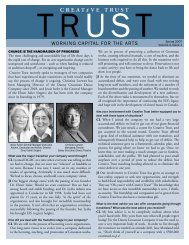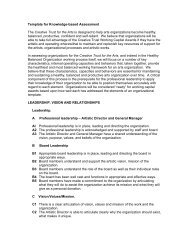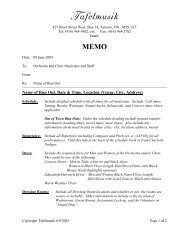20 Questions - Canadian Institute of Chartered Accountants
20 Questions - Canadian Institute of Chartered Accountants
20 Questions - Canadian Institute of Chartered Accountants
Create successful ePaper yourself
Turn your PDF publications into a flip-book with our unique Google optimized e-Paper software.
17. How much will be needed for buildings,<br />
furniture, vehicles and equipment?<br />
Organizations that expect to spend considerable amounts on capital assets<br />
(land, buildings, tools, equipment, vehicles information technology, etc.) typically<br />
develop a capital plan and budget for board approval. Capital plans and<br />
budgets estimate the cost <strong>of</strong> funding and acquiring capital assets and match<br />
fundraising and/or borrowing to the timing <strong>of</strong> expenditures. The principal considerations<br />
for the board are the costs and benefits <strong>of</strong> the proposed expenditures<br />
and the management <strong>of</strong> the cash flow.<br />
Organizations that regularly make substantial capital expenditures (e.g. hospitals,<br />
universities, school boards, etc) usually have capital planning and budgeting<br />
processes. For many organizations, however, major capital expenditures<br />
are relatively infrequent and they may not have processes in place to plan and<br />
manage them. Their boards need to understand and be prepared for the challenges<br />
involved.<br />
contractor. The result can be times when there is more cash than is immediately<br />
needed and times when the organization is short <strong>of</strong> cash. Capital budgeting<br />
includes projecting the cash flow and bank balances, and making plans to invest<br />
or borrow when there is too much or too little cash to meet upcoming payments.<br />
Budgets should recognize multi-year projects on a calendarized basis.<br />
Recommended practices<br />
• The organization has a capital plan and budget if these are needed<br />
• The plan describes the costs and benefits <strong>of</strong> acquiring capital assets<br />
• The plan includes consideration <strong>of</strong> alternatives to purchasing or building<br />
• The plan includes the sources <strong>of</strong> funding for capital projects<br />
• The budget includes a cash flow summary<br />
Not-for-pr<strong>of</strong>it capital planning (like business planning) looks for long-term<br />
benefits, compares the relative merits <strong>of</strong> proposed capital projects and considers<br />
alternatives such as leasing. It usually looks for improved program delivery<br />
rather than a pay-back in pr<strong>of</strong>it. The costs <strong>of</strong> using and maintaining the assets<br />
should be included in the operating budget. These include the expertise needed<br />
to keep the information and accounting systems and other assets working properly<br />
without interruptions that could affect service delivery.<br />
Smaller capital items can usually be purchased from an organization’s own<br />
funds. Larger projects typically require additional funding from private or<br />
government sources.<br />
A major challenge in capital budgeting is managing the cash flow. Once a<br />
capital project is started, the suppliers and contractors expect to be paid in<br />
accordance with their contracts. The funding for the project does not always<br />
arrive at the times when payments are due. For example: it is not unusual for<br />
organizations to raise part <strong>of</strong> the funds before the project contract begins and<br />
for government grants to be released only after the organization has paid the<br />
19












